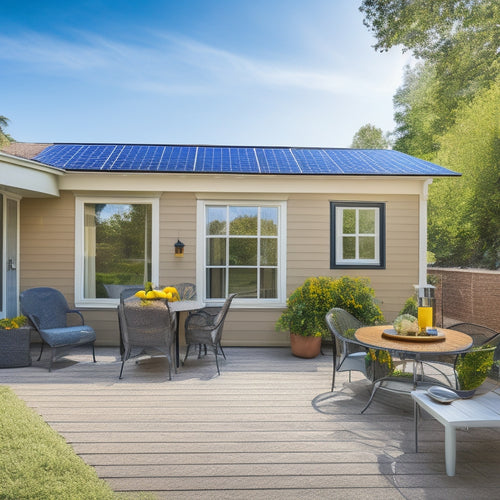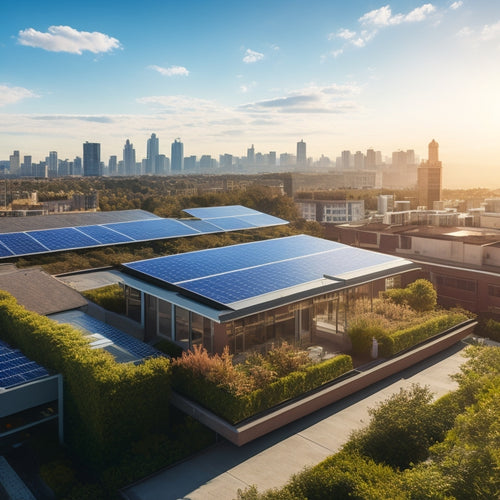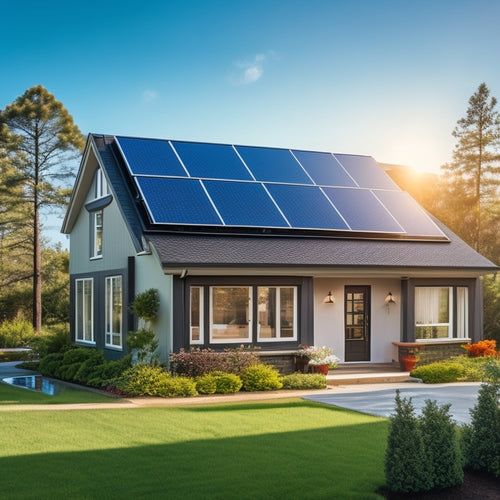
How Much Solar Power Do You Need for Your Home
Share
You need to determine how much solar power your home requires by evaluating your energy usage patterns, roof's solar potential, and considering local climate factors and energy storage needs. Start by conducting an energy audit to identify high energy-consuming appliances and lighting systems, then analyze past energy bills to determine your average daily energy consumption in kWh. Next, consider the efficiency ratings of solar panels, installation factors, and performance monitoring. Finally, factor in your energy storage needs, local climate, and roof's solar potential to size your solar panel system correctly. From here, you'll have a solid foundation to investigate the specifics of your solar power needs.
Key Takeaways
- Assess your energy needs by reviewing past bills, conducting an energy audit, and identifying high-energy appliances and lighting systems.
- Consider your lifestyle habits, energy usage patterns, and peak consumption periods to determine your daily energy consumption in kWh.
- Calculate your daily energy use by identifying appliance power ratings, daily routines, and energy-intensive appliances to optimize energy usage.
- Determine your roof's solar potential by assessing roof size, orientation, shading analysis, and structural integrity to ensure suitable installation.
- Evaluate system configuration options, including grid connection, off-grid, and hybrid systems, to determine the ideal solution for your energy independence goals.
Assessing Your Energy Needs
About 30% of your energy bill is likely attributed to lighting and appliances, making it essential to accurately assess your energy needs before installing a solar power system.
To do this, you'll need to evaluate your current energy usage and identify areas for energy conservation. Start by reviewing your past energy bills to determine your average daily energy consumption in kilowatt-hours (kWh).
Then, conduct an energy audit of your home to identify energy-intensive appliances and lighting systems. Consider making lifestyle changes, such as switching to energy-efficient LED bulbs or upgrading to energy-saving appliances, to reduce your energy needs.
You can also consider adjusting your daily habits, such as turning off lights and electronics when not in use, to further reduce your energy consumption.
Understanding Solar Panel Efficiency
With your energy needs assessment in hand, you're ready to investigate the world of solar panel efficiency, an essential factor in determining how much solar power you'll need to generate. Efficiency ratings vary among solar panel types, with monocrystalline panels typically boasting the highest efficiency ratings.
| Solar Panel Type | Efficiency Rating |
|---|---|
| Monocrystalline | 20-22% |
| Polycrystalline | 15-18% |
| Thin-Film | 7-14% |
| Bifacial | 18-22% |
| Perovskite | 20-25% |
Understanding these ratings is vital, as they directly impact the amount of energy your system can convert from sunlight. Installation factors, such as panel orientation and shading, also affect efficiency. Performance monitoring and maintenance practices can help optimize your system's energy conversion. Technological advancements and warranty considerations are also important when selecting the right solar panels for your home. By grasping these concepts, you'll be well-equipped to choose the most efficient solar panel system for your energy needs.
Calculating Your Daily Energy Use
You need to understand your energy usage patterns to determine how much solar power you require.
To do this, you'll need to identify the appliance power ratings in your home, which can be found on the manufacturer's labels or online documentation.
Energy Usage Patterns
Your daily routine is filled with energy-hungry appliances, from the morning coffee brewer to the evening TV broadcast, all contributing to your overall energy usage pattern.
Understanding these patterns is essential in determining how much solar power you need for your home.
Here are a few examples of how your daily habits impact your energy consumption trends:
-
Peak morning hours: Your morning routine, including hair dryers, toasters, and coffee makers, creates a significant energy spike.
-
Afternoon energy lull: As you're out and about, your energy usage tends to decrease, with only a few appliances like refrigerators and computers running in the background.
-
Evening energy surge: As you settle in for the night, your energy usage increases again with TVs, lamps, and kitchen appliances.
Analyzing these patterns helps you identify opportunities to improve your household energy efficiency.
Appliance Power Ratings
Appliances throughout your home consume energy at varying rates, measured in watts (W). To calculate your daily energy use, you need to determine the power ratings of each device. Check the nameplate or manufacturer's documentation for the wattage requirements of each appliance.
You'll notice that devices have different power ratings, reflecting their unique energy consumption patterns. Efficient appliances, like LED bulbs or Energy Star-rated refrigerators, generally have lower power ratings than their less efficient counterparts.
Understanding these ratings is essential for effective load management. By knowing the wattage requirements of each device type, you can prioritize energy-intensive appliances and adjust your usage habits accordingly.
Conducting an energy audit helps identify areas of high energy consumption, allowing you to optimize your energy use. When evaluating appliance power ratings, consider the frequency and duration of use.
This information will help you accurately calculate your daily energy needs and determine the right solar power system for your home.
Daily Watt-Hour Needs
Calculating daily energy use involves determining the total watt-hours (Wh) consumed by your appliances over a 24-hour period.
This calculation is essential in determining how much solar energy your home requires. To get an accurate estimate, you'll need to evaluate your consumption habits and the appliances you use daily.
Here are three examples of appliances you might use daily:
- Refrigerator: 1.5 kWh (kilowatt-hours) per day
- Laptop: 0.05 kWh per day
- LED TV: 0.2 kWh per day
Add up the total watt-hours consumed by each appliance to get your daily energy use.
For example, if you use your refrigerator for 8 hours, laptop for 4 hours, and LED TV for 2 hours, your daily energy use would be approximately 2.35 kWh.
This number will give you an idea of how much solar energy you need to generate to power your home.
Determining Your Roof's Solar Potential
Three key factors affect your roof's solar potential: its size, orientation, and shading. Your roof's size determines how many solar panels you can fit, while its orientation affects how much energy those panels can produce. Ideally, your roof should face south to maximize energy production.
Shading analysis is vital to identify areas where trees, buildings, or other obstructions block sunlight. This guarantees optimal panel placement for maximum energy generation.
Before installing solar panels, you need to verify your roof's structural integrity can support their weight. Local regulations may also impact your installation, so it's important to research and comply with them.
Installation costs, maintenance considerations, and incentive programs, such as solar incentives, should also be factored into your decision. Additionally, consider the aesthetic impact of solar panels on your home's appearance.
Accounting for Energy Storage Needs
With your solar panel system in place, you'll need to ponder how to store the excess energy it generates during the day for use at night or on cloudy days. This is where energy storage comes into play. You'll need to evaluate the battery capacity that suits your energy needs, factoring in aspects like storage technologies, inverter choices, and grid connection.
Here are three key factors to keep in mind:
-
Backup systems: You'll want a system that can provide backup power during outages, ensuring your home remains energized even when the grid is down.
-
Load management: You'll need to manage your energy load to optimize your storage capacity, prioritizing essential appliances like refrigerators and lighting.
-
Discharge cycles: You'll want to choose a battery with efficient discharge cycles to minimize energy loss and maximize your energy independence.
When selecting a storage solution, contemplate efficiency ratings, cost considerations, and the overall reliability of the system.
Considering Local Climate Factors
Having optimized your energy storage needs, you can now turn your attention to the impact of local climate factors on your solar panel system's performance.
Sunlight availability is a critical consideration, as regions with more sunny days will generate more power. Seasonal variations also play a role, with winter months typically producing less energy due to shorter days and lower sun angles.
Weather impact, such as heavy snowfall or extreme temperatures, can affect system performance and longevity. Shading effects from nearby structures or trees must also be assessed to guarantee ideal installation orientation.
Local regulations and solar incentives can greatly influence your system's economics. Research local policies and incentives to maximize your return on investment.
Additionally, consider climate resilience and energy independence when designing your system. Grid connection requirements and net metering policies may also impact your system's performance and energy independence.
Sizing Your Solar Panel System
When sizing your solar panel system, you'll need to contemplate two critical factors: system size and energy usage patterns.
The system size you require will depend on your home's energy demands, which are influenced by factors like your appliances, lighting, and insulation.
System Size Factors
Energy efficiency is at the forefront of your mind as you evaluate utilizing the power of the sun for your home.
You're thinking about the environmental benefits, the potential savings on your electricity bill, and the increased value of your property.
Now, it's time to determine the right system size for your solar panel installation.
To get an accurate estimate, you'll need to take into account the following factors:
-
Roof size and layout: How much space do you have available for solar panels, and what's the layout of your roof?
-
Shading and obstructions: Are there any trees, chimneys, or other obstructions that could impact the performance of your solar panels?
-
Local building codes and regulations: What're the specific requirements and restrictions in your area that may affect your system size?
Evaluating these factors will help you determine the ideal system size for your home.
Additionally, you'll want to weigh the costs and benefits of different system sizes, including the impact on installation costs and potential solar incentives.
Energy Usage Patterns
Your roof's size and layout, shading and obstructions, and local building codes have all been considered in determining the ideal system size for your solar panel installation.
Now, it's crucial to examine your energy usage patterns to confirm your system meets your power needs. You'll want to analyze your peak consumption periods, typically during hot summer afternoons or winter evenings, to determine the maximum power output required. Seasonal variations in energy usage will also impact your system's performance. For instance, if you have a pool or HVAC system, your energy consumption may spike during certain months.
To optimize your system's energy efficiency, consider your lifestyle habits, such as when you're home and using appliances. Behavioral changes, like shifting non-essential loads to off-peak hours, can also reduce your overall energy demand.
Conducting an energy audit can help identify areas for improvement and uncover opportunities for demand response strategies. Additionally, renewable incentives and potential power outages should be factored into your system design.
Evaluating System Configuration Options
Three key factors determine the ideal system configuration for your home: roof size and orientation, local building codes and regulations, and your desired level of energy independence.
Considering these factors, you'll want to assess the pros and cons of different system configurations. Here are three scenarios to imagine:
-
Grid Connection: You're connected to the grid, selling excess energy back to your utility company and drawing from the grid when needed. This setup is ideal for homes with limited roof space or high energy demands.
-
Off-Grid Options: You're entirely self-sufficient, relying on solar power and energy storage systems like batteries. This setup is perfect for remote locations or homes with low energy needs.
-
Hybrid Systems: You combine grid connection with energy storage, ensuring a reliable supply of power during outages or peak demand periods.
When evaluating system configurations, consider factors like inverter types, panel orientation, installation costs, maintenance requirements, local regulations, financing options, and performance warranties.
Getting a Professional Assessment
A thorough evaluation of your home's unique characteristics is vital in determining the perfect solar power system configuration. This is where a professional assessment comes in.
A site evaluation by a qualified contractor will assess your home's energy usage, roof size and orientation, shading, and local building codes to determine the best system size and configuration.
During a professional consultation, they'll discuss installation costs, equipment recommendations, and financial incentives that apply to your situation. They'll also consider maintenance considerations, local regulations, and their own contractor qualifications to guarantee a seamless installation process.
With their proficiency, you'll get a personalized assessment of your energy needs and a customized solution that meets your specific requirements. By leveraging their knowledge, you'll avoid costly mistakes and guarantee a solar power system that provides maximum energy output and savings.
Frequently Asked Questions
Can I Install Solar Panels on a Rented Property?
You can install solar panels on a rented property, but you'll need your landlord's permission and may require a solar lease agreement; research tenant rights in your area to guarantee you're protected and aware of any obligations.
Do Solar Panels Work During Power Outages?
As darkness falls, you crave freedom from the grid's shackles; with solar panels, you'll still be plunged into darkness during outages - unless you utilize solar battery storage, releasing grid independence and illuminating your path to self-sufficiency.
Are Solar Panels Compatible With All Roof Types?
You'll find that solar panels are compatible with most roof types, but you'll need to contemplate roof material compatibility and installation angle considerations, ensuring a secure and efficient setup that maximizes energy production.
Can I Add More Panels to My System Later?
Expanding your solar system is like upgrading a computer - you can add more RAM later. You can future-proof your system with design flexibility, allowing for seamless future expansion, and making it easy to add more panels as your energy needs grow.
Will Solar Panels Increase My Property Value?
You'll likely see a significant increase in your property worth with solar panels, as they're viewed as a worthwhile solar energy investment, offering home sale benefits like reduced energy costs and a competitive edge in the market.
Related Posts
-

10 Tips to Buy Affordable Solar Panels Online
When purchasing affordable solar panels online, you'll want to research reputable retailers, compare prices, and chec...
-

What Is the Cost to Put in Solar Panels
You're likely considering solar panels for your home, and the most significant factor in your decision is the upfront...
-

Solar Power Units Perfect for Homes
You're considering installing a solar power unit in your home, a decision that can notably reduce your reliance on tr...


